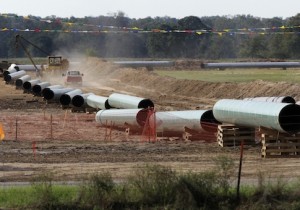U.S. President Barack Obama’s rejection on November 6 of the proposed Keystone SL oil pipeline project for supplying Canadian crude to the U.S. ends a seven-year debate. From the viewpoint of refinery planning and scheduling departments, the seven year wait has long since compelled cultivation of alternate transportation routes for receiving Western Canadian Select (WCS) and diluted bitumen (dilbit) to refineries in Illinois and the Gulf Coast.
Ostensibly, increased processing of shale-based light tight oils (LTOs) had led to speculation that if the Keystone Pipeline had actually been approved, that buildup of LTO inventories at major terminals, such as the Cushing, Oklahoma hub, would have resulted in an under-utilized Keystone pipeline. The counter-argument to this speculation is that heavy Canadian crude sources are the perfect partners for shale crudes from North Dakota and Texas, pointing to the strict U.S. refinery blending protocol (30 – 32 degrees API constraints) to explain why U.S. imports of light oils from countries such as Nigeria dwindled to only 60,000 bpd earlier this year, while refiners found ways to import record quantities of much heavier WCS.
Indeed, the current availability of deeply discounted crude oil from overseas compounded by the unexpected increase in U.S. fuel demand is so lucrative that some East Coast refineries are eliminating deliveries of North American sourced crudes altogether. The nearly 60% decline in crude oil prices since summer 2014 has made oil shipped from Latin America, the Middle East and Africa more economical, even when taking the transportation costs into consideration. For example, PBF’s Delaware City refinery is importing crude cargoes from Columbia and Peru, even after investing close to $50 million in rail terminal infrastructure for delivery of Bakken crude. As a matter of fact, rail shipments of Bakken crude to the Delaware City refinery have dwindled down to less than 17,000 bpd, according to recent press reports.
Aside from the political significance of the cancelled Keystone pipeline project, refiners have many more economic options for access to either light or heavy feedstocks compared to when the Keystone Pipeline controversy emerged almost eight years ago. WCS and dilbit are instead transportable with the reversal of the Seaway pipeline and continued construction of the southern leg of Keystone XL (KXL), allowing access to Gulf Coast refineries that process heavy oils. In addition, the Canadian Energy Research Institute (CERI) forecasts that non-conventional Canadian oil production will stabilize at about 3 million bpd and possibly 5 million bpd by 2030 — with our without Keystone.








Leave a Reply
You must be logged in to post a comment.